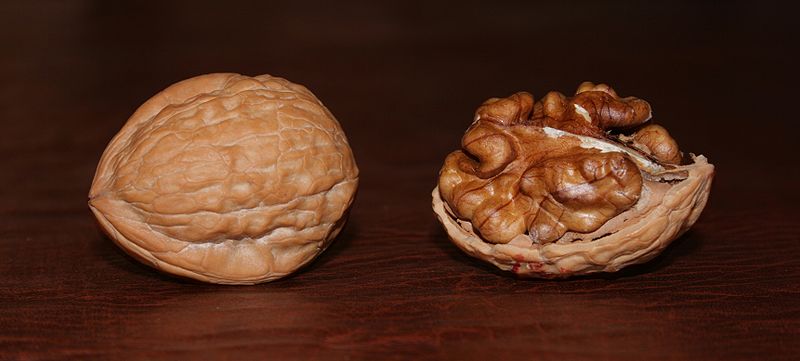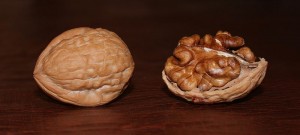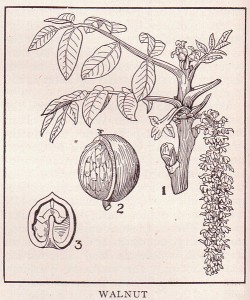
17 Oct the humble walnut
 Someone asked me today, ‘what is in walnuts?’ I know they are good for your brain. Perhaps this is another post in the series: ‘nutrition for the brain’. They are so delicious, but what are in them? And why are they so good for our brains?
Someone asked me today, ‘what is in walnuts?’ I know they are good for your brain. Perhaps this is another post in the series: ‘nutrition for the brain’. They are so delicious, but what are in them? And why are they so good for our brains?
Vitamins and minerals
Walnuts contain manganese, phosphorous, copper, iron, calcium and magnesium, however the reason why they are often called ‘brain food’ is because they contain Omega 3 fatty acids. (1) Our brains are structurally 60 % fat and the omega fats help keep the brain fluid and flexible. (1) A lecturer at a university I visited to consider studying naturopathy there said that walnuts are one of those foods that look like the organ that they are good for. They look like a brain! Just slightly more delicious! hehe
Also, due to the fact that they can triple the production of melatonin, which is the hormone which peaks in the evening as you go to bed, walnuts can be useful if you are having difficulty getting to sleep! (1)
Tree nut family
 They are part of the tree nut family, along with pine nuts, Brazil nuts, cashews, hazelnuts, macadamia nuts, pecans and pistachios. (2) Apparently the health benefits of this group of nuts cannot be overestimated. (2) The World’s Heathiest Foods website recommends consumption of an ounce or 28 g of this family of nuts per day to get the numerous benefits of these nuts, which are thought to be useful in different cancers, as well as type 2 diabetes, and metabolic syndrome. (2)
They are part of the tree nut family, along with pine nuts, Brazil nuts, cashews, hazelnuts, macadamia nuts, pecans and pistachios. (2) Apparently the health benefits of this group of nuts cannot be overestimated. (2) The World’s Heathiest Foods website recommends consumption of an ounce or 28 g of this family of nuts per day to get the numerous benefits of these nuts, which are thought to be useful in different cancers, as well as type 2 diabetes, and metabolic syndrome. (2)
Apparently the waxy skin is very good for you too, and should not be removed. Approximately 90% of the phenols in walnuts are found in the skin, including key phenolic acids, tannins, and flavonoids. (2)
In particular, the walnut contains an unusual but beneficial form of Vitamin E.
Instead of having most of its vitamin E present in the alpha-tocopherol form, walnuts provide an unusually high level of vitamin E in the form of gamma-tocopherol. Particularly in studies on the cardiovascular health of men, this gamma-tocopherol form of vitamin E has been found to provide significant protection from heart problems. (2)
Energy dense foods
The only problem is that walnuts are pretty high in energy (calories). I almost died when I realised that my regular consumption of them in tacos, which is nothing if not delicious clocks up something like 600 calories at worst and 300 calories at best! Unless the rest of your diet is completely plant based, this is not something to be eating three or four times a week! As scrumptious as walnut tacos are!
Lets do a quick comparison with beef, which you would normally use in tacos 🙂 100 g of ground beef has 332 calories, whereas 100 g of walnuts has 696 calories. :eek Oops! hehe.
(Oh no, I am going to turn into one of these people who is always calculating the energy density of foods! Boring! What is an education, though, if not for learning the ins and outs of these situations!)
Complete protein foods
They do contain all the essential amino acids, so on a vegetarian or plant food diet, they are a great way to get a good dose of complete protein!
As well as many other benefits but maybe a handful in a salad, or in a pesto, would be a better way to integrate this beneficial food if you are going down the path of a reduced energy diet. If not! Try the tacos. There really is nothing so delicious! 🙂 xxo
References
1. Lee Zalben. Walnuts the ultimate brain food. [Internet] Serious Eats; 2006 – 2012 [cited 2013 Oct 17] Available from: https://www.seriouseats.com/2010/06/walnuts-the-ultimate-brain-food.html
2. Walnuts. World’s Healthiest foods. [Internet] The George Mateljan Foundation; 2001 – 2013; [cited 2013 Oct 17] Available from: https://www.whfoods.com/genpage.php?tname=foodspice&dbid=99

Pingback:Why do walnuts look like brains? A brain health history - My Health Zest
Posted at 21:09h, 06 December[…] Walnuts are shaped like little brains. This is why they are sometimes called “brain nuts.” It’s not just the shape that makes walnuts great for brain health, though. The omega-3 fatty acids in walnuts help to keep the cell membranes of our brains healthy. Walnuts also contain alpha-linolenic acid which helps with blood flow in your brain and can even reduce symptoms of Alzheimer’s disease. These benefits make it clear why walnut consumption might be one of the best things you can do for your brain! But why do walnuts look like brains? Is there something in the history of walnuts that can tell us the answer? This post will discuss these things as well as explore the topic of walnuts and brain health. […]